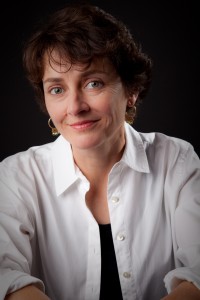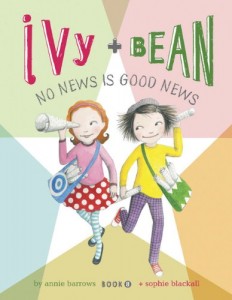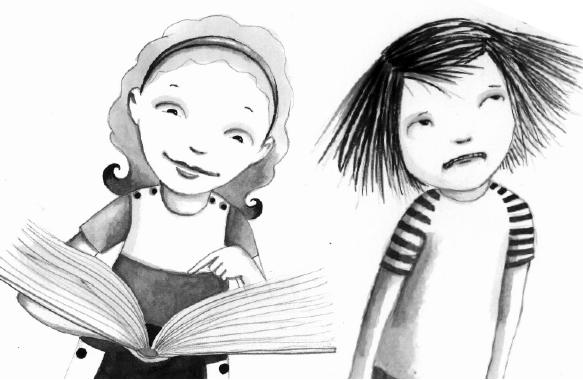By Nicki Richesin, The Children’s Book Review
Published: November 14, 2011

Annie Barrows is the enormously talented author of many acclaimed books including the Ivy + Bean series, The Magic Half, and The Guernsey Literary & Potato Peel Pie Society. She has also written non-fiction books under the pen name Ann Fiery. Annie’s latest book in the Ivy + Bean series is No News Is Good News. She worked for years as an editor until she decided to write children’s books like the ones she loved growing up. Her dedicated fans are eternally grateful she decided to pursue her dream.
Nicki Richesin: Congratulations on your great success with the Ivy + Bean series. When I gave my daughter your latest book No News Is Good News, she disappeared with a greedy look in her eye and resurfaced a few hours later. It must feel incredibly satisfying to know children are devoted to the characters you’ve brought to life with your words and eager to read about their next adventures.
Annie Barrows: I’m always happy when I see a kid wrapped up in a book—even happier when the book in question is one of mine.
 I admired your description of how children who are opposites can often form a beautiful friendship. There is a yin and yang element to Ivy and Bean’s friendship that keeps their relationship ticking along and also adds tension. Was this your original intent when you first created these characters?
I admired your description of how children who are opposites can often form a beautiful friendship. There is a yin and yang element to Ivy and Bean’s friendship that keeps their relationship ticking along and also adds tension. Was this your original intent when you first created these characters?
I guess I was mostly trying to create characters who lead with their imaginations—that is something that Ivy and Bean have in common—and it just turned out that they have different ways of being in the world. I read a lot of books in which the kids seem pretty generic, but kids, like grownups, have pretty distinct characters. Actually, because they’re not smoothed over by social niceties, they are more distinct than adults.
Like many of your devoted readers, I fell madly in love with The Guernsey Literary & Potato Peel Pie Society. You present such a fascinating setting and a rag-tag cast of loony yet lovable characters in this novel rich with hope and possibilities. Of course, I loved the plucky heroine you created in Juliet. The story is told in a series of beautifully crafted letters. I’m sure this must have proved a hindrance to your story-telling in some ways, but freed you in terms of a constantly changing voice that moves the story along. Did you find this to be true while writing the book?
The epistolary aspect of the book was something I inherited from my aunt and co-author, Mary Ann Shaffer. I think it’s the ideal way to tell about a historic period—our credibility would have been severely undermined by having a smaller clutch of characters who happened to experience a majority of the events of the Occupation. With upwards of 26 characters, we could cover the range of episodes in a range of voices, which was great. Plus, you always get a pop from a first-person POV. It has its drawbacks, but it does have energy.
I understand your aunt Mary Ann Shaffer asked you to help her finish the novel as she was very ill and you were the other born storyteller in the family. Could you talk about what it was like to work with her and how she influenced your writing life? What would she think of the international acclaim the novel has received?
I didn’t really work with Mary Ann, because she was sick. I worked with the manuscript she had written, which was wonderful because it was like hearing her tell a story. Hearing Mary Ann tell a story was one of life’s great pleasures—everyone who ever had that experience feels the same way about it—and I believe that working on Guernsey, swimming in a Mary Ann story, so to speak, gave me an understanding of the mechanics of storytelling that I never could have gotten any other way. I think Mary Ann would be thrilled—and abashed—by the reception of the novel.You worked as an editor for Chronicle Books for many years. How is it working as an author for a publishing house where you once worked in-house? It seems like you could insist on voo-doo dolls in your books, if you wanted!
Ha! Because I knew who I was arguing with, I knew I’d never win. I think it’s a huge advantage working with a house I know so intimately. First, I know what their strengths are, and I know how I can work with those strengths. Second, they aren’t the Mysterious Monolith—I know how they’re structured, which is really helpful. And third, since it was so long ago that I worked there, all my former colleagues are now very august and powerful, so I have friends in high places.
I have to ask this question: have you ever been a member of a book club? I imagine you are contacted by them on a regular basis to discuss The Guernsey Literary & Potato Peel Pie Society. Do you, or have you ever, worked with a group of writers or do you prefer to work alone with your editor?
Oh boy. For years, I’ve been afraid that someone was going to ask me this. No, I have never belonged to a book club because, well, to be honest, I’m too disobedient. If someone tells me to read a book, I won’t. There are many many things I must do in my life, but reading is my freedom. I like to meander, to follow the whim of my interests. The structure of the Guernsey Literary and Potato Peel Pie Society might have worked for me, but most current book clubs involve group reading, and that would just make me cranky.
I got an MFA, which is like having a writing group, a very surly writing group. Now I work alone—though I do sometimes ask certain friends to read my stuff for me. Bless them.
In your website biography, you allude to a ghost in your aunt’s house. Could you please tell our readers about this phantom? You also mentioned that there were a number of books that were important to you when you were young. Which ones meant the most to you?
Funny—this ghost keeps cropping up. Yes, Mary Ann and her family lived for a couple of years in a house that was haunted. I don’t know much about the ghost—it never materialized, although it did make a lot of noise—but it was not a cute, happy, friendly ghost. It was a scary ghost.
As for childhood reading, the list goes on and on. Among my favorites were the Betsy-Tacy books, the Little House on the Prairie books, Edward Eager’s books, and a book called Time at the Top, which was probably the best reading experience of my entire life.
How do you like collaborating with Sophie Blackall? Did she initially present sketches of Ivy and Bean to you or did she fashion them completely realized in one go?
I love love love Sophie, but I can’t claim any responsibility for pairing her with Ivy and Bean. Chronicle Books spent a year trying to find the right artist for Ivy and Bean and then—magic!—Sophie did a sketch that showed she was the exact right person.

I LOVED The Magic Half. Are you stilling planning on writing a prequel?
I love The Magic Half, too. And I have a prequel idea for a book about Maud, Molly’s mother. But about five months ago, I got a totally brilliant idea for a sequel, so I think that’s the direction in which I’m going to head—as soon as I finish my next novel for grownups, which is taking forever.
What can we expect next in the continuing adventures of Ivy + Bean?
I have written the ninth book, but I can only say one word about its contents: Camp.
Please describe your fantasy breakfast.
Easy-peasy: Grapefruit juice, delicious berries, buckwheat pancakes, and an ENORMOUS cup of coffee. I had it last week in Los Angeles. Yum.
Thank you so much for your time and continued success to you with all your many books!
*The Mary Ann Shaffer Memorial Fund provides a scholarship at Soapstone, the Writing Retreat for Women, for an unpublished writer who has shown a serious commitment to writing. If you’re interested in donating to the fund, donate online through Network for Good. In the “Designation” line, enter “In memory of Mary Ann Shaffer.”
Nicki Richesin is the editor of four anthologies,What I Would Tell Her: 28 Devoted Dads on Bringing Up, Holding On To, and Letting Go of Their Daughters; Because I Love Her: 34 Women Writers Reflect on the Mother-Daughter Bond; Crush: 26 Real-Life Tales of First Love; and The May Queen: Women on Life, Work, and Pulling it all Together in your Thirties. Her anthologies have been excerpted and praised in The New York Times, the San Francisco Chronicle, The Boston Globe, Redbook, Parenting, Cosmopolitan, Bust, Daily Candy, and Babble.
